DeWalt DW925 Handleiding
DeWalt
Boormachine
DW925
Bekijk gratis de handleiding van DeWalt DW925 (25 pagina’s), behorend tot de categorie Boormachine. Deze gids werd als nuttig beoordeeld door 64 mensen en kreeg gemiddeld 4.5 sterren uit 32.5 reviews. Heb je een vraag over DeWalt DW925 of wil je andere gebruikers van dit product iets vragen? Stel een vraag
Pagina 1/25

INSTRUCTION MANUAL
GUIDE D'UTILISATION
MANUAL DE INSTRUCCIONES
DW925
Cordless Adjustable Clutch Driver/Drill
Perceuse-tournevis sans fil à embrayage réglable
Taladro/Destornillador Inalámbrico con Embrague Ajustable
INSTRUCTIVO DE OPERACIÓN, CENTROS DE SERVICIO Y
PÓLIZA DE GARANTÍA. ADVERTENCIA: LÉASE ESTE
INSTRUCTIVO ANTES DE USAR EL PRODUCTO.
IF YOU HAVE ANY QUESTIONS OR COMMENTS ABOUT THIS OR ANY D EWALT TOOL,
CALL US TOLL FREE AT:
1-800-4-DEWALT (1-800-433-9258)
General Safety Instructions for All Battery Operated
Tools
WARNING! Read and understand all instructions. Failure to follow all instructions listed below,
may result in electric shock, fire and/or serious personal injury.
SAVE THESE INSTRUCTIONS
WORK AREA
• Keep your work area clean and well lit. Cluttered benches and dark areas invite accidents.
• Do not operate power tools in explosive atmospheres, such as in the presence of flam-
mable liquids, gases, or dust. Power tools create sparks which may ignite the dust or fumes.
• Keep bystanders, children, and visitors away while operating a power tool. Distractions can
cause you to lose control.
ELECTRICAL SAFETY
• Do not abuse the cord. Never use the cord to carry the tool. Keep cord away from heat, oil,
sharp edges or moving parts. Replace damaged cords immediately. Damaged cords may create
a fire.
• A battery operated tool with integral batteries or a separate battery pack must be
recharged only with the specified charger for the battery. A charger that may be suitable for
one type of battery may create a risk of fire when used with another battery.
• Use battery operated tool only with specifically designated battery pack. Use of any other
batteries may create a risk of fire.
PERSONAL SAFETY
• Stay alert, watch what you are doing and use common sense when operating a power
tool. Do not use tool while tired or under the influence of drugs, alcohol, or medication. A moment
of inattention while operating power tools may result in serious personal injury,
• Dress properly. Do not wear loose clothing or jewelry. Contain long hair. Keep your hair, cloth-
ing , and gloves away from moving parts. Loose clothes, jewelry, or long hair can be caught in
moving parts.
• Avoid accidental starting. Be sure switch is in the locked or off position before inserting battery
pack. Carrying tools with your finger on the switch or inserting the battery pack into a tool with the
switch on invites accidents.
• Remove adjusting keys or wrenches before turning the tool on. A wrench or a key that is left
attached to a rotating part of the tool may result in personal injury.
• Do not overreach. Keep proper footing and balance at all times. Proper footing and balance
enables better control of the tool in unexpected situations.
• Use safety equipment. Always wear eye protection. Dust mask, non-skid safety shoes, hard hat,
or hearing protection must be used for appropriate conditions.
TOOL USE AND CARE
• Use clamps or other practical way to secure and support the workpiece to a stable plat-
form. Holding the work by hand or against your body is unstable and may lead to loss of control.
• Do not force tool. Use the correct tool for your application. The correct tool will do the job bet-
ter and safer at the rate for which it is designed.
• Do not use tool if switch does not turn it on or off. Any tool that cannot be controlled with the
switch is dangerous and must be repaired.
• Disconnect battery pack from tool or place the switch in the locked or off positionbefore
making any adjustments, changing accessories, or storing the tool. Such preventative safe-
ty measures reduce the risk of starting the tool accidentally.
• Store idle tools out of reach of children and other untrained persons. Tools are dangerous
in the hands of untrained users.
• When battery pack is not in use, keep it away from metal objects like: paper clips, coins, keys,
nails, screws, or other small metal objects that can make a connection from one terminal to the
other. Shorting the battery terminals together may cause sparks, burns, or a fire.
• Maintain tools with care. Keep cutting tools sharp and clean. Properly maintained tools, with
sharp cutting edges are less likely to bind and are easier to control.
• Check for misalignment or binding of moving parts, breakage of parts, and any other con-
dition that may affect the tools operation. If damaged, have the tool serviced before using.
Many accidents are caused by poorly maintained tools.
• Use only accessories that are recommended by the manufacturer for your model.
Accessories that may be suitable for one tool may create a risk of injury when used on another
tool.
SERVICE
• Tool service must be performed only by qualified repair personnel. Service or maintenance
performed by unqualified personnel may result in a risk of injury.
• When servicing a tool, use only identical replacement parts. Follow instructions in the
Maintenance section of this manual. Use of unauthorized parts or failure to follow Maintenance
Instructions may create a risk of shock or injury.
Additional Specific Safety Instructions
• Hold tool by insulated gripping surfaces when performing an operation where the cutting
tool may contact hidden wiring. Contact with a “live” wire will also make exposed metal parts
of the tool “live” and shock the operator.
WARNING: Use of this tool can generate dust containing chemicals known to cause can-
cer, birth defects or other reproductive harm. Use appropriate respiratory protection.
• When working on a ladder or on scaffolding be sure to lay the tool down on its side
when not in use. Some tools with large battery packs will stand upright but may be easily
knocked over.
• The label on your tool may include the following symbols.
V ..............volts A ................amperes
Hz ............hertz W ..............watts
min ..........minutes ............alternating current
..........direct current no ..............no load speed
............Class II ..............earthing terminal
................Construction ..............safety alert symbo
.../min ......revolutions per minute
Important Safety Instructions for Battery Chargers
• This manual contains important safety and operating instructions.
• Before using charger, read all instructions and cautionary markings on (1) charger, (2) bat-
tery pack, and (3) product using battery pack.
• DANGER: 120 volts present at charging terminals. Do not probe with conductive objects.
Danger of electric shock or electrocution.
• DANGER: If battery pack case is cracked or damaged, do not insert into charger. Danger
of electric shock or electrocution.
• The charger and battery pack are specifically designed to work together. DO NOT attempt
to charge the battery pack with any chargers other than the ones in this manual.
• Do not expose charger to rain or snow.
• These chargers are not intended for any uses other than charging DeWalt rechargeable bat-
teries. Any other uses may result in risk of fire, electric shock or electrocution.
• To reduce risk of damage to electric plug and cord, pull by plug rather than cord when dis-
connecting charger.
• Make sure cord is located so that it will not be stepped on, tripped over, or otherwise sub-
jected to damage or stress.
• An extension cord should not be used unless absolutely necessary. Use of improper exten-
sion cord could result in risk of fire, electric shock, or electrocution.
• An extension cord must have adequate wire size (AWG or American Wire Gauge) for safe-
ty. The smaller the gauge number of the wire, the greater the capacity of the cable, that is
16 gauge has more capacity than 18 gauge. When using more than one extension to make
up the total length, be sure each individual extension contains at least the minimum wire
size.
RECOMMENDED MINIMUM AWG SIZE FOR EXTENSION CORDS
Total Extension Cord Length (feet)
25 50 75 100 125 150 175
Wire Gauge
18 18 16 16 14 14 12
• The charger is ventilated through slots in the top and the bottom of the housing. Do not
place any object on top of charger or place the charger on a soft surface that might block
the ventilation slots and result in excessive internal heat. Place the charger in a position
away from any heat source.
• Do not operate charger with damaged cord or plug — have them replaced immediately.
• Do not operate charger if it has received a sharp blow, been dropped, or otherwise dam-
aged in any way; take it to an authorized service center.
• Do not disassemble charger; take it to an authorized service center when service or repair
is required. Incorrect reassembly may result in a risk of electric shock, electrocution or fire.
• To reduce risk of electric shock, unplug charger from outlet before attempting any cleaning.
Removing the battery pack will not reduce this risk.
• NEVER attempt to connect 2 chargers together.
• DO NOT store or use the tool and battery pack in locations where the temperature may
reach or exceed 105°F (such as outside sheds or metal buildings in summer).
• The charger is designed to operate on standard household electrical power (120 Volts). Do
not attempt to use it on any other voltage!
Important Safety Instructions for Battery Packs
The battery pack is not fully charged out of the carton! First read the safety instructions below.
Then follow charging notes and procedures.
READ ALL INSTRUCTIONS.
• Do not incinerate the battery pack even if it is severely damaged or is completely worn
out.The battery pack can explode in a fire.
• A small leakage of liquid from the battery pack cells may occur under extreme usage or tem-
perature conditions. This does not indicate a failure. However, if the outer seal is broken and
this leakage gets on your skin:
a. Wash quickly with soap and water.
b. Neutralize with a mild acid such as lemon juice or vinegar.
c. If battery liquid gets into your eyes, flush them with clean water for a minimum of 10 min-
utes and seek immediate medical attention. (Medical note: The liquid is 25-35% solution of
potassium hydroxide.)
• Never attempt to open the battery pack for any reason. If the plastic housing of the battery
pack breaks or cracks, immediately discontinue use and do not recharge.
• Do not carry extra battery packs in aprons, pockets, or tool boxes along with other metal
objects. Battery pack could be short circuited causing damage to the battery pack and pos-
sibly causing severe burns or fire.
• Charge the battery packs only in DeWalt chargers.
• NOTE: Review and observe all of the “Important Charging Notes” in the charger instruction
section of this manual.
• NOTE: The batteries in your battery pack are the nickel–cadmium type. Cadmium is con-
sidered to be a toxic material by the Environmental Protection Agency. Before disposing of
damaged or worn out Nickel–Cadmium battery packs, check with your state Environmental
Protection Agency to find out about special restrictions on the disposal of these battery
packs or return them to a DeWALT certified service center for recycling.
Battery Packs
Your tool uses a 7.2, Volt D WALT battery pack. When ordering replacement battery packs,E
be sure to include catalog number and voltage.
D EWALT Industrial Tool Co., 701 East Joppa Road, Baltimore, MD 21286
Printed in China (FEB00) Form No. 498294 DW925 Copyright © 2000
Questions? See us in the World Wide Web at www.dewalt.com

The RBRC™ Seal
The RBRC™ (Rechargeable Battery Recycling Corporation) Seal on the nickel-
cadmium battery (or battery pack) indicates that the costs to recycle the battery
(or battery pack) at the end of its useful life have already been paid by DeWalt.
In some areas, it is illegal to place spent nickel-cadmium batteries in the trash or
municipal solid waste stream and the RBRC program provides an environmen-
tally conscious alternative.
RBRC in cooperation with DeWalt and other battery users, has established programs in the
United States to facilitate the collection of spent nickel-cadmium batteries. Help protect our
environment and conserve natural resources by returning the spent nickel-cadmium battery to
an authorized DeWalt service center or to your local retailer for recycling. You may also con-
tact your local recycling center for information on where to drop off the spent battery.
Chargers
Your battery can be charged in DEWALT 1 Hour Chargers or 15 Minute Chargers. Be sure to
read all safety instructions before using your charger.
Charging Procedure
These chargers require no adjustment and are designed to be as easy as possible to oper-
ate. Simply place your battery pack into the receptacle of a plugged in charger (FIG.1) and it
will automatically charge the pack.
1 HOUR CHARGERS
1. Plug the charger into an appropriate AC power outlet.
2. Insert the battery pack into the charger, as shown in FIG.1, making sure the pack is fully
seated in the charger. The red (charging) light will blink continuously indicating that the
charging process has started.
3. The battery pack will be fully charged in about 1 hour. The completion of charge will be indi-
cated by the red light remaining ON continuously. The pack is fully charged and may be
used at this time or left in the charger.
15 MINUTE CHARGERS
1. Plug the charger into an appropriate AC power outlet. The charger will beep twice, the red
light will blink and go off.
2. Insert the battery pack into the charger, as shown in FIG. 1, making sure the pack is fully
seated in the charger. The red light will blink and the charger will beep once indicating the
charging process has started.
3. The battery pack will be fully charged in less than 15 minutes under most conditions. This
will be indicated by the red light remaining ON and 3 beeps. The pack is fully charged and
may be used at this time or left in the charger.
Weak Battery Packs: (15 Minute Chargers). The charger can also detect a weak battery.
Such batteries are still usable but should not be expected to perform as much work. In such
cases, about 10 seconds after battery insertion, the charger will beep rapidly 8 times to indi-
cate a weak battery condition. The charger will then go on to charge the battery to the high-
est capacity possible.
Leaving the battery pack in the charger: When the red light remains ON, the charger has
switched to its "equalize charge" mode which lasts approximately 4 hours, after which the
charger will switch to "maintenance charge" mode. The battery pack can be removed at any
time during these charge cycles, but will only be fully charged if the red light is continuously
ON. The charger and battery pack can be left connected with the red light glowing indefinite-
ly. The charger will keep the battery pack fresh and fully charged. A battery pack will slowly
lose its charge when kept out of the charger. If the battery pack has not been kept on main-
tenance charge, it may need to be recharged before use. A battery pack may also slowly lose
its charge if left in a charger that is not plugged into an appropriate AC source.
Trouble Indicators: These chargers are designed to detect certain problems that can arise
with battery packs which would be indicated by the red light flashing at a fast rate (and con-
tinuous beeping for 15 Minute Chargers). If this occurs, re-insert battery pack. If problem per-
sists, try a different battery pack to determine if the charger is OK. If the new pack charges
correctly, then the original pack is defective and should be returned to a service center for
recycling. If the new battery pack elicits the same trouble indication as the original, have
charger tested at an authorized service center.
PROBLEM POWER LINE
If your charger has a Problem Power Line indicator: When the charger ‘is used with some
portable power sources such as generators or sources that convert DC to AC, the charger may
temporarily suspend operation, flashing the red light with two fast blinks followed by a
pause. This indicates the power source is out of limits.
HOT PACK DELAY
If your charger has a Hot Pack Delay feature: When the charger detects a battery that is hot, it
automatically starts a Hot Pack Delay, suspending charging until the battery has cooled. After
the battery has cooled, the charger automatically switches to the Pack Charging mode. This
feature ensures maximum battery life. The red light flashes long, then short while in the Hot
Pack Delay mode.
Installing and Removing the Battery Pack
NOTE: Make sure your battery pack is fully charged.
To install the battery pack into the tool handle, align the base of the tool with the notch
inside the tool’s handle (FIG. 2) and slide the battery pack firmly into the handle until you hear
the lock snap into place as shown in FIG. 3.
To remove the battery pack from the tool, press the release buttons and firmly pull the bat-
tery pack out of the tool handle. Insert it into the charger as described in the charger section
of this manual.
Important Charging Notes
1. Longest life and best performance can be obtained if the battery pack is charged when the
air temperature is between 65°F and 75°F (18°- 24°C). DO NOT charge the battery pack
in an air temperature below +40°F(+4.5°C), or above +105°F (+40.5°C). This is important
and will prevent serious damage to the battery pack.
2. The charger and battery pack may become warm to touch while charging. This is a normal
condition, and does not indicate a problem.
3. The 15 minute charger has an internal temperature limit that, when exceeded, will tem-
porarily stop the full charge current. This is indicated by the yellow light being ON. The nor-
mal charge cycle will resume when the temperature falls below the preset limit and will be
indicated by the yellow light turning OFF. The charge time may be extended beyond the
normal 15 minutes. Use the charger in normal room temperatures whenever possible. To
prevent overheating, do not cover the charger and do not charge battery packs in direct
sunlight or near heat sources.
4. If the battery pack does not charge properly — (1) Check current at receptacle by plugging
in a lamp or other appliance, (2) Check to see if receptacle is connected to a light switch
which turns power off when you turn out the lights. (3) Move charger and battery pack to a
location where the surrounding air temperature is approximately 65°F - 75°F (18°- 24°C).
(4) If charging problems persist, take or send the tool, battery pack and charger to your
local service center.
5. The battery pack should be recharged when it fails to produce sufficient power on jobs
which were easily done previously. DO NOT CONTINUE to use under these conditions.
Follow the charging procedure. You may also charge a partially used pack whenever you
desire with no adverse affect on the battery pack.
6. Under certain conditions, with the charger plugged in to the power supply, the exposed
charging contacts inside the charger can be shorted by foreign material. Foreign materials
of a conductive nature such as, but not limited to, steel wool, aluminum foil, or any buildup
of metallic particles should be kept away from charger cavities. Always unplug the charg-
er from the power supply when there is no battery pack in the cavity. Unplug charger before
attempting to clean.
7. Do not freeze or immerse charger in water or any other liquid.
8. WARNING: Don't allow any liquid to get inside charger. Electric shock may result. To
facilitate the cooling of the battery pack after use, avoid placing the charger or battery pack
in a warm environment such as in a metal shed, or an uninsulated trailer.
9. CAUTION: Never attempt to open the battery pack for any reason. If the plastic housing
of the battery pack breaks or cracks, return to a service center for recycling.
Important!
This product is not user servicable. There are no user servicable parts inside the charger.
Servicing at an authorized service center is required to avoid damage to static sensitive inter-
nal components.
READ ALL OF THE INSTRUCTIONS IN THE BATTERY CHARGER SECTION OF THIS
MANUAL BEFORE ATTEMPTING TO CHARGE THE BATTERY PACK FOR YOUR TOOL.
Always use correct battery pack (pack supplied with tool or replacement pack exactly like it.)
Never install any other battery pack. It will ruin your tool and may create a hazardous condi-
tion.
Variable Speed Switch (Fig. 4)
To turn the tool on, squeeze the trigger switch (A). To turn the tool off, release the trigger
switch. Your tool is equipped with a brake. The chuck will stop as soon as the trigger switch
is fully released.
The variable speed switch enables you to select the best speed for a particular application.
The farther you squeeze the trigger, the faster the tool will operate. Use lower speeds for start-
ing holes without a centerpunch, drilling in metals or plastics, driving screws and drilling
ceramics. Higher speeds are better for drilling in wood, wood compositions and for using abra-
sive and polishing accessories. For maximum tool life, use variable speed only for starting
holes or fasteners.
NOTE: Continuous use in variable speed range is not recommended. It may damage the
switch and should be avoided.
Forward/Reverse Control Button (Fig. 4)
A forward/reverse control button (B) determines the direction of the tool and also serves as a
lock off button. To select forward rotation, release the trigger switch and depress the for-
ward/reverse control button on the right side of the tool.To select reverse, depress the for-
ward/reverse control button on the left side of the tool. The center position of the control but-
ton locks the tool in the off position. When changing the position of the control button, be sure
the trigger is released. The first time the tool is run after changing the direction of rota-NOTE:
tion, you may hear a click on start up. This is normal and does not indicate a problem.
Torque Adjustment Collar (Fig. 5)
The torque adjustment collar (A) is clearly marked with numbers and a drill bit symbol.The col-
lar should be rotated until the desired setting is located at the top of the tool. Locators are pro-
vided in the collar to eliminate the guess work when selecting fastening torque. The higher the
number on the collar, the higher the torque and the larger the fastener which can be driven.
To lock the clutch for drilling operations, move to the drill bit position.
NOTE: When using the Drill/Driver for drilling holes, be sure that the Torque Adjusting Collar
is set so the figure of the drill is aligned with the arrow on the top of the tool. Failure to do this
will allow the clutch to slip while attempting to drill
Keyless Chuck (Fig. 6)
Your tool features a keyless chuck for greater convenience. To insert a drill bit or other acces-
sory, follow the steps listed below.
1. Lock the trigger switch in the off position as described earlier.
2. Grasp the rear half of the chuck with one hand and use your other hand to rotate the front
half counterclockwise, as shown in FIG 6. Rotate far enough so that the chuck opens suffi-
ciently to accept the desired accessory.
3. Insert the bit or other accessory about 3/4” into the chuck and tighten securely by holding the
rear half of the chuck and rotating the front portion in the clockwise direction.
To release the accessory, repeat step 2 listed above.
WARNING: Do not attempt to tighten drill bits (or any other accessory) by gripping the front
part of the chuck and turning the tool on. Damage to the chuck and personal injury may result.
Always lock off trigger switch when changing accessories.
Be sure to tighten chuck with two hands on both the rear sleeve and the forward sleeve for max-
imum tightness.
Chuck Removal (Fig. 7)
Always wear eye protection.
Turn the adjustment collar to the “drill” position. Tighten the chuck around the shorter end of a
hex key (not supplied) of 1/4” or greater size. Using a wooden mallet or similar object, strike the
longer end in the clockwise direction, as shown in FIG. 7. This will loosen the screw inside the
chuck.
Open chuck jaws fully, insert screwdriver (or Torx tool if required) into front of chuck between
jaws to engage screw head. Remove screw by turning clockwise (left-hand-thread). Place hex
key in chuck and tighten, as shown in FIG. 8. Using a wooden mallet or similar object, strike
key sharply in the counterclockwise direction. This will loosen the chuck so that it can be
unscrewed by hand.
Chuck Installation (Fig. 8)
Screw the chuck on by hand as far as it will go and insert screw (LH thread). Tighten screw
securely. Tighten the chuck around the shorter end of a 1/4” or larger hex key (not supplied)
strike the longer end in the clockwise direction with a wooden mallet, as shown in FIG. 7. Tighten
the screw once again by turning in a counterclockwise direction.
Operation as a Drill
Turn the collar to the drill bit symbol. Install and tighten the desired drill bit in the chuck. Follow
these instructions for best results when drilling:
DRILLING
1. Use sharp drill bits only. For WOOD, use twist drill bits, spade bits, power auger bits, or
hole saws. For METAL, use high speed steel twist drill bits or hole saws.
2. Be sure the material to be drilled is anchored or clamped firmly. If drilling thin material, use
a “back-up” block to prevent damage to the material.
3. Always apply pressure in a straight line with the bit. Use enough pressure to keep the drill bit
biting, but do not push hard enough to stall the motor or deflect the bit.
4. Hold tool firmly to control the twisting action of the drill.
5. IF DRILL STALLS, it is usually because it is being overloaded. RELEASE TRIGGER
IMMEDIATELY, remove drill bit from work, and determine cause of stalling. DO NOT CLICK
TRIGGER OFF AND ON IN AN ATTEMPT TO START A STALLED DRILL – THIS CAN
DAMAGE THE DRILL.
6. To minimize stalling or breaking through the material, reduce pressure on drill and ease the
bit through the last fractional part of the hole.
7. Keep the motor running when pulling the bit back out of a drilled hole. This will help prevent
jamming.
8. With variable speed drills there is no need to center punch the point to be drilled. Use a slow
speed to start the hole and accelerate by squeezing the trigger harder when the hole is deep
enough to drill without the bit skipping out. Operate at full on after starting the bit.
Drilling in Wood
Holes in wood can be made with the same twist drills used for metal. These bits may overheat
unless pulled out frequently to clear chips from the flutes. For larger holes, use low speed wood
bits. Work that is likely to splinter should be backed up with a block of wood.
Drilling in Metals
Use a cutting lubricant when drilling metals. The exceptions are cast iron and brass which
should be drilled dry. The cutting lubricants that work best are sulphurized cutting oil or lard oil;
bacon grease will also serve the purpose.
Operation as a Screwdriver
Insert the desired fastener accessory into the chuck as you would any drill bit. Make a few
practice runs in scrap or unseen areas to determine the proper position of the clutch collar.
Maintenance
CLEANING: With the motor running, blow dirt and dust out of all air vents with dry air at least
once a week. Wear safety glasses when performing this. Exterior plastic parts may be cleaned
with a damp cloth and mild detergent. Although these parts are highly solvent resistant,
NEVER use solvents.

POUR TOUT RENSEIGNEMENT SUPPLÉMENTAIRE SUR CET OUTIL OU TOUT AUTRE
OUTIL DEWALT, COMPOSER SANS FRAIS LE NUMÉRO :
1 800 4-D WALT (1 800 433-9258)E
Regles de sécurité générales pour tous les outils à
baterie
AVERTISSEMENT! Vous devez lire et comprendre toutes les instructions. Le non-
respect, même partiel, des instructions ci-après entraîne un risque de choc électrique, d’in-
cendie et/ou de blessures graves.
CONSERVEZ CES INSTRUCTIONS.
AIRE DE TRAVAIL
• Veillez à ce que l’aire de travail soit propre et bien éclairée. Le désordre et le manque de
lumière favorisent les accidents.
• N’utilisez pas d’outils électriques dans une atmosphère explosive, par exemple en
présence de liquides, de gaz ou de poussières inflammables. Les outils électriques créent
des étincelles qui pourraient enflammer les poussières ou les vapeurs.
• Tenez à distance les curieux, les enfants et les visiteurs pendant que vous travaillez avec
un outil électrique. Ils pourraient vous distraire et vous faire faire une fausse manoeuvre.
SÉCURITÉ ÉLECTRIQUE
• Ne maltraitez pas le cordon. Ne transportez pas l’outil par son cordon et ne débranchez pas la
fiche en tirant sur le cordon. N’exposez pas le cordon à la chaleur, à des huiles, à des arêtes vives
ou à des pièces en mouvement. Remplacez immédiatement un cordon endommagé. Un cordon
endommagé augmente le risque de choc électrique.
• Un outil à bloc-batterrie amovible ou à batterie intégrée ne doit être rechargé qu’avec le
chargeur prévu pour la batterie. Un chargeur qui convient à tel type de batterie peut présen-
teer un risque d’incendie avec tel autre type de batterie.
• N’utilisez un outil qu’avec un bloc-batterie conçu spécifiquement pour lui. L’emploi d’un
autre bloc-batterie peut créerr un risque d’incendie.
SÉCURITÉ DES PERSONNES
• Restez alerte, concentrez-vous sur votre travail et faites preuve de jugement. N’utilisez pas
un outil électrique si vous êtes fatigué ou sous l’influence de drogues, d’alcool ou de médica-
ments. Un instant d’inattention suffit pour entraîner des blessures graves.
• Habillez-vous convenablement. Ne portez ni vêtements flottants ni bijoux. Confinez les
cheveux longs. N’approchez jamais les cheveux, les vêtements ou les gants des pièces en mou-
vement. Des vêtements flottants, des bijoux ou des cheveux longs risquent d’être happés par des
pièces en mouvement.
• Méfiez-vous d’un démarrage accidental. Avant d’insérer un bloc-batterie, assurez-vous quee
l’interrupteur de l’outil est sur ARRÊT. Le fait de transporter un outil avec le doigt sur la détente
ou d’insérer un bloc-batterie alors que l’interrrupteur set en position MARCHE peut mener tout
droit à un accident.
• Enlevez les clés de réglage ou de serrage avant de démarrer l’outil. Une clé laissée dans un
pièce tournante de l’outil peut provoquer des blessures.
• Ne vous penchez pas trop en avant. Maintenez un bon appui et restez en équilibre en tout
temps. Un bonne stabilité vous permet de mieux réagir à une situation inattendue.
• Utilisez des accessoires de sécurité. Portez toujours des lunettes ou une visière. Selon les
conditions, portez aussi un masque antipoussière, des bottes de sécurité antidérapantes, un
casque protecteur et/ou un appareil antibruit.
UTILISATION ET ENTRETIEN DES OUTILS
• Immobilisez le matériau sur une surface stable au moyen de brides ou de toute autre
façon adéquate. Le fait de tenir la pièce avec la main ou contre votre corps offre un stabilité
insuffisante et peut amener un dérapage de l’outil.
• Ne forcez pas l’outil. Utilisez l’outil approprié à la tâche. L’outil correct fonctionne mieux et de
façon plus sécuritaire. Respectez aussi la vitesse de travail qui lui est propre.
• N’utilisez pas un outil si son interrupteur est bloqué. Un outil que vous ne pouvez pas com-
mander par son interrupteur est dangereux et droit être réparé.
• Retirez le bloc-batterie ou mettez l’interrupteur sur ARRÊT ou en position verrouillée
avant d’effectuer un réglage, de changer d’accessoire ou de ranger l’outil. De telled
mesures préventives réduisent le rrisque de démarrrage accidentel d l’outil.
• Rangez les outils hors de la portée des enfantes et d’autres personnes inexpérimentées.
Les outils sont dangereux dans les mains d’utilisateurs novices.
• Lorsque le bloc-batterie n’est pas en service, tenez-le à l’écart d’autres métalliques (trom-
bones, pièces de monnaie. clés, clous, vis, etc.) susceptibles d’établir un contact élec-
trique entre les deux bornes. La mise en court-circuit des bornes de la batterie peut produire
des éntincelles et constitue un risque de brûlures ou d’incendie.
• Prenez soin de bien entretenir les outils. Les outils de coupe doivent être toujours bien affûtés
et propres. Des outils bien entretenus, dont les arêtes sont bien tranchantes, sont moins sus-
ceptibles de coincer et plus faciles à diriger.
• Soyez attentif à tout désalignement ou coincement des pièces en mouvement, à tout bris
ou à toute autre condition préjudiciable au bon fonctionnement de l’outil. Si vous constatez
qu’un outil est endommagé, faites-le réparer avant de vous en servir. De nombreux accidents
sont causés par des outils en mauvais état.
• N’utilisez que des accessoires que le fabricant recommande pour votre modèle d’outil. Certains
accessoires peuvent convenir à un outil, mais être dangereux avec autre.
RÉPARATION
• La réparation des outils électriques doit être confiée à un réparateur qualifié. L’entretien ou
la réparation d’un outil électrique par un amateur peut avoir des conséquences graves.
• Pour la réparation d’un outil, n’employez que des pièces de rechange d’origine. Suivez les
directives données à la section «Réparation» de ce manuel. L’emploi de pièces non autorisées
ou le non-respect des instructions d’entretien peut créer un risque de choc électrique ou de
blessures.
Règles de sécurité additionnelles
• Tenir l’outil par les surfaces isolées prévues à cette fin lorsqu’il risque d’entrer en
contact avec des fils cachés ou son propre cordon, car de tels contacts peuvent mettre
les pièces métalliques de l’outil sous tension, engendrant des risques de choc électrique.
• Lorsqu’on est installé sur une échelle ou un échafaudage pour travailler, on doit
déposer l’outil sur le côté lorsqu’on ne s’en sert plus. Bien que certains outils munis
d’un gros bloc-piles puissent être placés à la verticale, dans cette position, ils peuvent facile-
ment être renversés.
•L’étiquette de l’outil peut comporter les symboles suivants.
V ..................volts A ..................ampères
Hz ................hertz W ..................watts
min................minutes ................courant alternatif
..............courant continu no..................sous vide
..................Construction de ..................borne de mise à la minute
....................classe II ../min ............tours à la minute
................symbole d´avertissement
CONSERVER CES MESURES
Importantes mesures de sécurité relatives au chargeur
• Le présent guide contient des conseils importants relatifs à la sécurité et à l’utilisation.
• Bien lire toutes les directives et tous les avertissements qui se trouvent sur (1) le chargeur, (2)
l’ensemble de piles et (3) l’outil avant d’utiliser le chargeur.
• DANGER : Les bornes du chargeur sont sous une tension de 120 volts. Ne pas les examin-
er avec un objet conducteur; cela présente des risques de secousses électriques.
•DANGER : Ne pas placer dans le chargeur un ensemble de piles craqué ou endommagé; cela
présente des risques de secousses électriques.
• Le chargeur et l’ensemble de piles ont été conçus pour fonctionner ensemble. NE JAMAIS ten-
ter de charger l’ensemble de piles à l’aide d’un chargeur autre que ceux décrits dans le présent
guide.
• Protéger le chargeur de la pluie ou de la neige.
• L’utilisation du chargeur pour tout ensemble de piles autre que les ensembles rechargeables
DEWALT comporte des risques d’incendie et de secousses électriques.
• Pour minimiser les risques de dommages au cordon et à sa fiche, débrancher l’appareil en tirant
sur la fiche plutôt que sur le cordon.
• Veiller à ce que le cordon soit rangé de sorte qu’on ne marche pas dessus, qu’il ne présente pas
de risques de blessures, et qu’il ne soit pas autrement sujet aux dommages et aux contraintes.
• Sauf nécessité absolue, ne jamais utiliser de cordon de rallonge. L’utilisation d’un cordon de ral-
longe non conforme présente des risques d’incendies et de secousses électriques.
• Les cordons de rallonge doivent être faits de conducteurs de calibre approprié (AWG ou jauge
américaine des fils) par mesure de sécurité. Le numéro de calibre du fil est inversement propor-
tionnel à la capacité du cordon. Ainsi, un cordon de calibre 16 a une capacité supérieure à celle
d’un cordon de calibre 18. Lorsqu’il est nècessaire d’utiliser plus d’un cordon de rallonge, veiller
à ce que chaque cordon ait au moins le calibre minimal.
CALIBRE MINIMAL RECOMMANDÉ (AWG)
POUR LES CORDONS DE RALLONGE
Longueur totale de cordon de rallonge (en mètres)
7,6 15 30 50
Calibre (AWG) du cordon
18 18 16 14
• La ventilation du chargeur se fait par les fentes sur le dessus et le dessous de l’appareil. Ne rien
déposer sur le chargeur et ne pas déposer ce dernier sur une surface qui pourrait en bloquer les
orifices car cela risque de provoquer la surchauffe de l’appareil. Éloigner le chargeur des sources
de chaleur.
• Ne jamais se servir du chargeur lorsque le cordon ou la fiche sont endommagés. Les remplacer
immédiatement.
• Ne jamais se servir d’un chargeur qui a encaissé un coup brusque, qui est tombé ou qui est
endommagé. Le faire vérifier à un centre de service autorisé.
• Ne jamais démonter le chargeur. N’en confier la réparation ou l’entretien qu’à un centre de ser-
vice autorisé. Le remontage non conforme du produit comporte des risques d’incendies ou de
secousses électriques.
• Pour minimiser les risques de secousses électriques, débrancher le chargeur de la prise de
courant avant de le nettoyer. Le risque n’est pas éliminé en enlevant l’ensemble de piles du
chargeur.
• NE JAMAIS raccorder deux chargeurs l’un à l’autre.
• NE PAS ranger le produit dans un endroit où la température peut atteindre ou dépasser 40 °C
(105 °F) (comme dans une remise métallique en été).
• Le chargeur est conçu pour fonctionner sur une alimentation domestique standard (120 volts).
Ne pas essayer de s’en servir sous toute autre tension.
Importantes mesures de sécurité relatives aux ensembles
de piles
L’ensemble de piles n’est pas complètement chargé à sa sortie de l’usine. Lire d’abord les instruc-
tions suivantes, puis se conformer aux directives relatives au chargement.
LIRE TOUTES LES DIRECTIVES.
• Ne pas incinérer l’ensemble de piles même s’il est très endommagé ou complètement usé. La
chaleur des flammes peut faire exploser les piles.
• Il peut se produire une légère fuite du liquide excitateur des piles dans des conditions d’utilisa-
CHARGER CLEANING INSTRUCTIONS:
WARNING: Disconnect the charger from the AC outlet before cleaning.
Dirt and grease may be removed from the exterior of the charger using a cloth or soft non-
metallic brush. Do not use water or any cleaning solutions.
Accessories
Recommended accessories for use with your tool are available at extra cost from your local
service center.
CAUTION: The use of any non-recommended accessory may be hazardous.
If you need any assistance in locating any accessory, please contact D EWALT Industrial Tool
Co., 701 East Joppa Road, Baltimore, MD 21286 or call 1-800-4-D WALT. (1-800-433-9258)E
Maximum Recommended Capacity
BITS, METAL DRILLING 3/8"
WOOD, FLAT BORING 3/8”
Important
To assure product SAFETY and RELIABILITY, repairs, maintenance and adjustment (includ-
ing brush inspection and replacement) should be performed by certified service centers or
other qualified service organizations, always using identical replacement parts.
Full Warranty
DEWALT heavy duty industrial tools are warranted for one year from date of purchase. We will
repair, without charge, any defects due to faulty materials or workmanship. For warranty repair
information, call 1-800-4-DEWALT. This warranty does not apply to accessories or damage
caused where repairs have been made or attempted by others. This warranty gives you spe-
cific legal rights and you may have other rights which vary in certain states or provinces.
In addition to the warranty, D EWALT tools are covered by our:
30 DAY NO RISK SATISFACTION GUARANTEE
If you are not completely satisfied with the performance of your D EWALT heavy duty industri-
al tool, simply return it to the participating seller within 30 days for a full refund. Please return
the complete unit, transportation prepaid. Proof of purchase may be required.
FIG. 1 FIG. 3
FIG. 2
FIG. 4
FIG. 5
A
FIG.8
FIG. 7
BBFIG. 6
Product specificaties
| Merk: | DeWalt |
| Categorie: | Boormachine |
| Model: | DW925 |
Heb je hulp nodig?
Als je hulp nodig hebt met DeWalt DW925 stel dan hieronder een vraag en andere gebruikers zullen je antwoorden
Handleiding Boormachine DeWalt
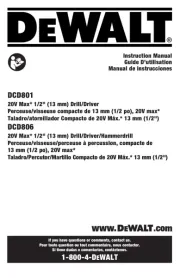
3 Augustus 2025
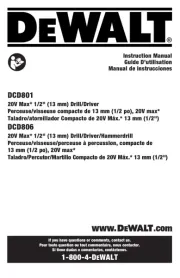
29 Juli 2025

4 Juli 2025
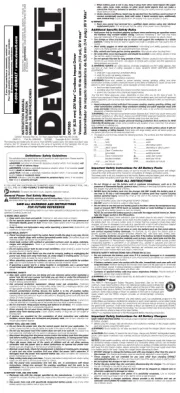
10 Juni 2025

2 Januari 2025

22 November 2024

15 November 2024

2 November 2024

23 September 2024

11 September 2024
Handleiding Boormachine
- Total
- Draper
- Topcraft
- Stomer
- Goon
- MyTool
- G-Technology
- Ferrex
- Graphite
- Lux Tools
- Vonroc
- Hitachi
- Makita
- Rothenberger
- Steren
Nieuwste handleidingen voor Boormachine
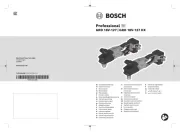
16 September 2025
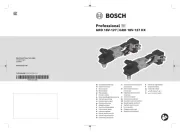
16 September 2025
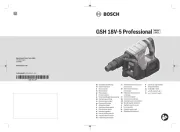
15 September 2025
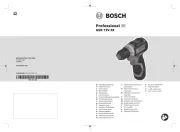
15 September 2025
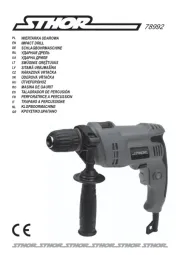
13 September 2025
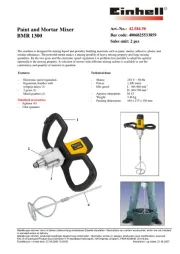
13 September 2025
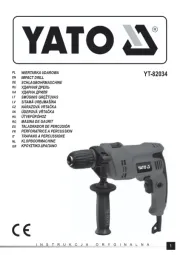
12 September 2025
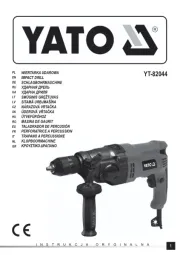
12 September 2025
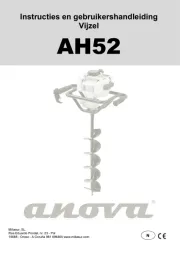
9 September 2025
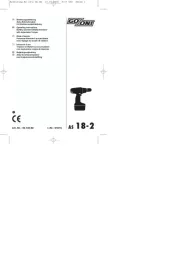
8 September 2025